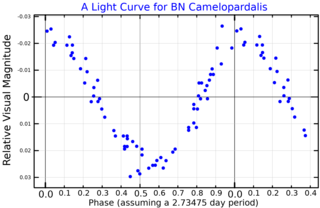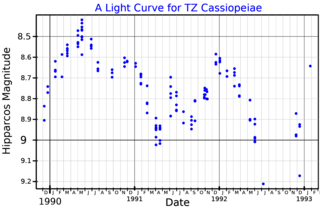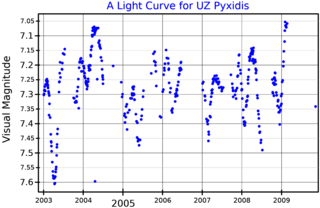
Tau Virginis is a single star in the zodiac constellation Virgo. With an apparent visual magnitude of 4.28, it is faintly visible to the naked eye. The distance to Tau Virginis, based upon parallax measurements, is approximately 225 light years with a margin of error of ±3 light years.
R Apodis is a solitary star in the constellation Apus. It is faintly visible to the naked eye as an orange-hued point of light with an apparent magnitude of 5.36. Parallax measurements imply a distance of 413 light-years and it is drifting closer with a heliocentric radial velocity of −31.2 km/s. At its current distance, R Apodis' brightness is diminished by an interstellar extinction of 0.26 magnitudes and it has an absolute magnitude of −0.22.

UU Aurigae is a carbon star in the constellation Auriga. It is approximately 341 parsecs from Earth. It is a variable star that is occasionally bright enough to be seen by the naked eye under excellent observing conditions.

CS Camelopardalis is a binary star in reflection nebula VdB 14, in the constellation Camelopardalis.
42 Camelopardalis is a single star in the constellation Camelopardalis, located roughly 770 light years away from the Sun. It is visible to the naked eye as a faint, blue-white hued star with an apparent visual magnitude of 5.14. The visual magnitude of the star is diminished by an extinction of 0.22 due to interstellar dust. It is moving further from the Earth with a heliocentric radial velocity of 3 km/s. 42 Camelopardalis has a peculiar velocity of 24.4+1.9
−2.1 km/s and may be a runaway star.

53 Camelopardalis is a binary star system in the northern circumpolar constellation of Camelopardalis, located 290 light years away from the Sun as determined by parallax measurements. It has the variable star designation AX Camelopardalis; 53 Camelopardalis is the Flamsteed designation. This object is dimly visible to the naked eye as a white hued star with a baseline apparent visual magnitude of +6.02. It is a single-lined spectroscopic binary system with an orbital period of 6.63 years and a high eccentricity of 0.718. The "a sin i" value of the primary is 280 Gm (1.9 AU), where a is the semimajor axis and i is the orbital inclination.
HD 42818 is a suspected astrometric binary star system in the northern circumpolar constellation of Camelopardalis. It is visible to the naked eye with an apparent visual magnitude of +4.76. Based upon an annual parallax shift of 18.64±0.23 mas as seen from Earth's orbit, it is located some 175 light years away. The system appears to be moving closer with a heliocentric radial velocity of −7 km/s. As of 2012, it is estimated that the system will make its closest approach to the Sun in 485,000 years at a distance of around 169.2 ly (51.87 pc).

Pi Cassiopeiae, Latinized from π Cassiopeiae, is a close binary star system in the constellation Cassiopeia. It is visible to the naked eye with an apparent visual magnitude of +4.949. Based upon an annual parallax shift of 18.63 mas as seen from Earth, this system is located about 175 light years from the Sun.

R Andromedae is a Mira-type variable star in the constellation Andromeda. Its spectral class is type S because it shows absorption bands of zirconium monoxide (ZrO) in its spectrum. It was among the stars found by Paul Merrill to show absorption lines of the unstable element technetium, establishing that nucleosynthesis must be occurring in stars. The SH molecule was found for the first time outside earth in the atmosphere of this star. The star is losing mass due to stellar winds at a rate of 1.09×10−6M☉/yr.

CQ Camelopardalis, abbreviated as CQ Cam, is a solitary variable star in the northern circumpolar constellation Camelopardalis. It has an apparent magnitude of 5.19, making it visible to the naked eye under ideal conditions. The object is relatively far at a distance of about 2,000 light years but is drifting closer with a heliocentric radial velocity of −22 km/s. It has a peculiar velocity of 21.8+2.1
−1.9 km/s, making it a runaway star.
HR 3082 is a double star in the northern circumpolar constellation of Camelopardalis. It is faintly visible to the naked eye with an apparent visual magnitude of 5.39. The system is moving closer to the Sun with a heliocentric radial velocity of +2.7 km/s. It is currently at a distance of around 341 light years, based upon an annual parallax shift of 9.57 mas.

HD 27245, also known as HR 1335 or rarely 25 H. Camelopardalis is a solitary red-hued star located in the northern circumpolar constellation Camelopardalis. It has an apparent magnitude of 5.4, making it faintly visible to the naked eye. Gaia DR3 Parallax measurements place it approximately 607 light years away from it the Solar System and is drifting further away with a heliocentric radial velocity of 25.2 km/s. At its current distance, HD 27245's brightness is diminished by 0.36 magnitudes due to extinction from interstellar dust. It has an absolute magnitude of −0.27.

BN Camelopardalis is a suspected astrometric binary in the northern circumpolar constellation of Camelopardalis. It appears as a variable star that is visible to the naked eye as a dim, white-hued point of light with an apparent visual magnitude that fluctuates around 5.49. The system is located at a distance of around 310 light years from the Sun based on parallax, and is drifting further away with a radial velocity of +9 km/s.

Pi Herculis is a third-magnitude star in the constellation Hercules. As one of the four stars in the Keystone asterism, specifically representing the northeastern corner, it is one of the constellation's more easily recognized. It has an apparent visual magnitude of +3.2, which is visible to the naked eye and makes it one of its brighter members. The Gaia spacecraft mission estimated its distance at roughly 112 parsecs from Earth, or about 367 light years away. The overall reduction in the star's visual magnitude due to extinction from the intervening cosmic dust is 0.11.

TZ Cassiopeiae(TZ Cas, HIP 117763, SAO 20912) is a variable star in the constellation Cassiopeia with an apparent magnitude of around +9 to +10. It is approximately 8,400 light-years away from Earth. The star is a red supergiant star with a spectral type of M3 and a temperature around 3,600 K.

1 Camelopardalis is a double star system in the constellation Camelopardalis. Its combined apparent magnitude is 5.56 and it is approximately 800 parsecs (2,600 ly) away.

37 Comae Berenices is a variable star system located around 690 light years away from the Sun in the northern constellation of Coma Berenices. It has the variable star designation LU Comae Berenices. 37 Comae Berenices was a later Flamsteed designation of 13 Canum Venaticorum. This object is visible to the naked eye as a faint, yellow-hued star with a baseline apparent visual magnitude of 4.88. It is drifting closer to the Earth with a heliocentric radial velocity of −14 km/s.

X Cancri is a variable star in the northern constellation of Cancer. It has a red hue and is visible to the naked eye at its brightest. The distance to this object is approximately 1,860 light years based on parallax measurements, but is drifting closer with a radial velocity of −5 km/s. It lies very close to the ecliptic and so is subject to lunar occultations.

UZ Pyxidis is a semiregular variable star in the constellation Pyxis. It is located about 3,600 light-years away from the Earth.

HD 26764, also known as HR 1314 or rarely 14 H. Camelopardalis, is a solitary white hued star located in the northern circumpolar constellation Camelopardalis. It has an apparent magnitude of 5.19, making it faintly to the naked eye if viewed under good conditions. Gaia DR3 parallax measurements place the object at a distance of 266 light years and is drifting closer with a poorly constrained heliocentric radial velocity of 3 km/s. At its current distance, HD 26764's brightness is diminished by 0.26 magnitudes due to interstellar dust.














